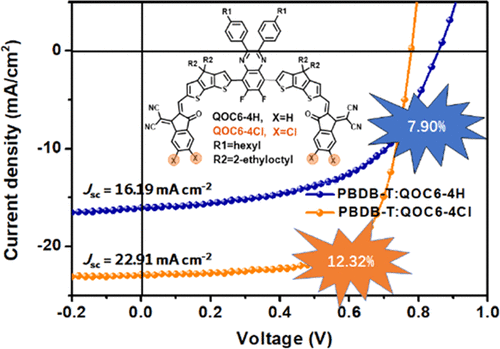当前位置:
X-MOL 学术
›
ACS Appl. Mater. Interfaces
›
论文详情
Our official English website, www.x-mol.net, welcomes your
feedback! (Note: you will need to create a separate account there.)
Facile Modification of a Noncovalently Fused-Ring Electron Acceptor Enables Efficient Organic Solar Cells
ACS Applied Materials & Interfaces ( IF 8.3 ) Pub Date : 2021-09-15 , DOI: 10.1021/acsami.1c11412 Jinfeng Huang 1, 2 , Sunsun Li 3 , Jinzhao Qin 2, 4 , Lei Xu 3 , Xiaozhang Zhu 5 , Lian-Ming Yang 1
ACS Applied Materials & Interfaces ( IF 8.3 ) Pub Date : 2021-09-15 , DOI: 10.1021/acsami.1c11412 Jinfeng Huang 1, 2 , Sunsun Li 3 , Jinzhao Qin 2, 4 , Lei Xu 3 , Xiaozhang Zhu 5 , Lian-Ming Yang 1
Affiliation

|
Electron acceptors with nonfused aromatic cores (NCAs) have aroused increasing interest in organic solar cells due to the low synthetic complexity and flexible chemical modification, but the corresponding device performance still lags behind. Herein, we designed and synthesized two new quinoxaline-based NCAs, namely, QOC6-4H and QOC6-4Cl. Although both NCAs show good backbone coplanarity, QOC6-4Cl with chlorinated end groups exhibits higher extinction coefficient, enhanced crystallinity, and more compact π–π stacking, which is correlated with the stronger intermolecular interactions induced by chlorine atoms. Benefiting from the broader and stronger optical absorption, improved carrier mobilities, and suppressed charge recombination, a notable power conversion efficiency (PCE) of 12.32% with a distinctly higher short-current density (Jsc) of 22.91 mA cm–2 and a fill factor (FF) of 69.01% could be obtained for the PBDB-T:QOC6-4Cl-based device. The PCEs of PBDB-T:QOC6-4H were only lower than 8%, which could mainly be attributed to the unsymmetric charge transport. Our work proves that the chlorination of end groups is a facile and effective strategy to enhance the intermolecular interactions and thus the photovoltaic performance of NCAs, and a careful modulation of the intermolecular interactions plays a vital role in further developing both high-performance and low-cost organic photovoltaic materials.
中文翻译:

非共价稠环电子受体的简单修饰使高效有机太阳能电池成为可能
由于低合成复杂性和灵活的化学修饰,具有非稠合芳香核(NCA)的电子受体引起了有机太阳能电池越来越多的兴趣,但相应的器件性能仍然落后。在此,我们设计并合成了两种新的基于喹喔啉的 NCA,即 QOC6-4H 和 QOC6-4Cl。尽管两种 NCA 都显示出良好的骨架共面性,但具有氯化端基的 QOC6-4Cl 表现出更高的消光系数、增强的结晶度和更紧凑的 π-π 堆积,这与氯原子引起的更强的分子间相互作用有关。得益于更广泛和更强的光吸收、改进的载流子迁移率和抑制电荷复合,显着的 12.32% 的功率转换效率 (PCE) 和明显更高的短电流密度(对于基于 PBDB-T:QOC6-4Cl 的器件,可以获得22.91 mA cm –2 的J sc )和 69.01% 的填充因子 (FF)。PBDB-T:QOC6-4H 的 PCE 仅低于 8%,这主要归因于不对称的电荷传输。我们的工作证明,端基的氯化是一种简单有效的策略,可以增强 NCA 的分子间相互作用,从而提高 NCA 的光伏性能,并且仔细调节分子间相互作用对于进一步开发高性能和低成本有机光伏材料。
更新日期:2021-09-29
中文翻译:

非共价稠环电子受体的简单修饰使高效有机太阳能电池成为可能
由于低合成复杂性和灵活的化学修饰,具有非稠合芳香核(NCA)的电子受体引起了有机太阳能电池越来越多的兴趣,但相应的器件性能仍然落后。在此,我们设计并合成了两种新的基于喹喔啉的 NCA,即 QOC6-4H 和 QOC6-4Cl。尽管两种 NCA 都显示出良好的骨架共面性,但具有氯化端基的 QOC6-4Cl 表现出更高的消光系数、增强的结晶度和更紧凑的 π-π 堆积,这与氯原子引起的更强的分子间相互作用有关。得益于更广泛和更强的光吸收、改进的载流子迁移率和抑制电荷复合,显着的 12.32% 的功率转换效率 (PCE) 和明显更高的短电流密度(对于基于 PBDB-T:QOC6-4Cl 的器件,可以获得22.91 mA cm –2 的J sc )和 69.01% 的填充因子 (FF)。PBDB-T:QOC6-4H 的 PCE 仅低于 8%,这主要归因于不对称的电荷传输。我们的工作证明,端基的氯化是一种简单有效的策略,可以增强 NCA 的分子间相互作用,从而提高 NCA 的光伏性能,并且仔细调节分子间相互作用对于进一步开发高性能和低成本有机光伏材料。











































 京公网安备 11010802027423号
京公网安备 11010802027423号